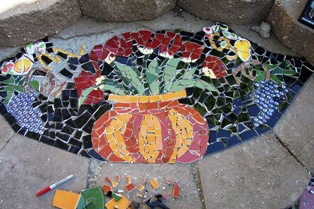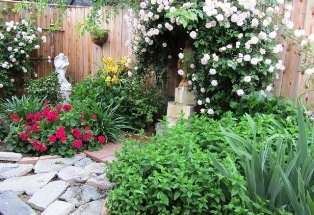Gardens as Sacred Space

Painted with the French words for peace, love, and prayer, the blue trellis serves as a garden focal point
In seed time learn, in harvest teach, in winter enjoy.–William Blake
It feels like winter. No sun after a clear, cold night. The temperature at Lake Tahoe this morning was a level zero. Here on the farmette, the temperature is having trouble pushing out of the 40s. Though bleak outside, there is light and warmth in our little farmhouse. Soup gurgles in the pot on the back burner, and the seed catalogs are close at hand.
Remembering visionary poet William Blake’s admonishment to enjoy winter, I’m trying. The seed catalogs remind me of plants and gardens of my past, the great gardens of the world, and the secret places that all gardens hold–places awaiting discovery or re-discovery. Places that create magic in a garden.
My garden isn’t just a place to cultivate plants; it exists as sacred space, a tranquil retreat. There under trees and amid the roses that I invariably plant, my restless spirit knows its place and can find its peace.
Gardens are so much more than trees and flowers, chimes, statuary, benches, and fountains of flowing water. Far more important than what is visible in a garden is what is not seen . . . but felt.
A garden is a place of presence. One of my favorite writers John O’donohue, Anam Cara and Eternal Echoes) observed, “that presence is alive.” Sacred space beckons us to step away from the cacophony of the world and enter Kairos or God’s time to dream, create, pray, love, nuture Self, and experience the wild presences of Nature.

The best gardens always have a little surprise; this is a garden step I created some years ago while writing my Adventures in Mosaic book
We step in and out of the garden, a living and ever-changing landscape, but it is only when we linger in the landscape that we are embraced by the unseen–what O’Donohue referred to as silent and indirect presences.
A garden nourishes and nurtures. It was to the garden I turned after losing five family members in five years; my mother and my 46-year-old husband were the last to go. I hid myself away in our garden, turned on the water, and allowed my own tears to flow until none were left.
Later, I spent hours in the garden, mourning my loss, remembering my dreams, re-imaging my future, and praying for my aching heart to heal. Relief came as I created pique assiette mosaics and photographed them for a book to be published.
From broken china pieces and colored glass, I created a child’s tea table. When a local teacher told me about a girl in her class whose father needed a heart transplant and had no money for Christmas presents, I gave the table to his little girl.
In my garden, I found healing and wholeness and strength to again step into life. The power of sacred space can do that. It can uplift your spirit and nourish you with light and warmth when all seems so terribly bleak. Best of all, garden memories are bearers of light and joy, nourishing your spirit even on the darkest, coldest days of winter.
Tags: landscape, light bearer, mosaic, mourn, pique assiette, power, presence, sacred space, spirit, William Blake, winter
 Facebook
Facebook Goodreads
Goodreads LinkedIn
LinkedIn Meera Lester
Meera Lester Twitter
Twitter



